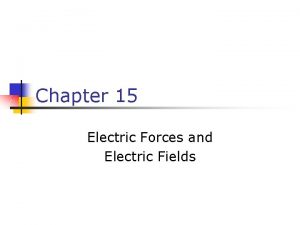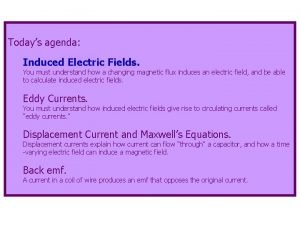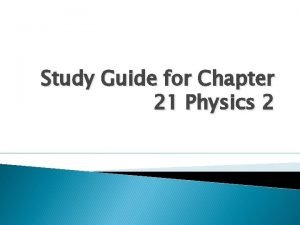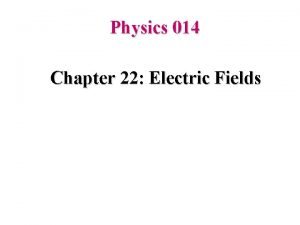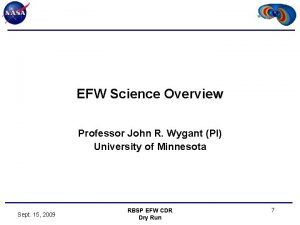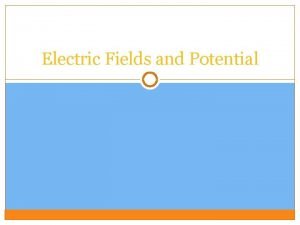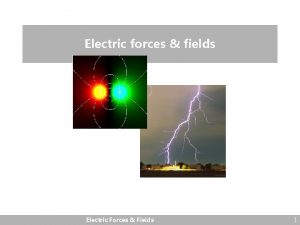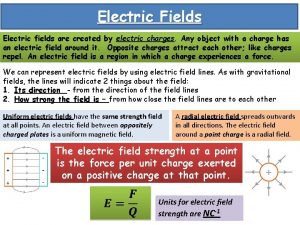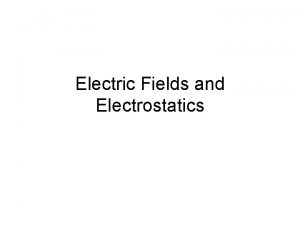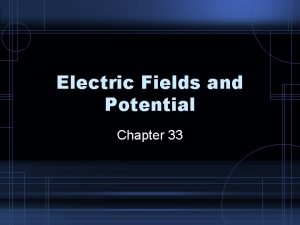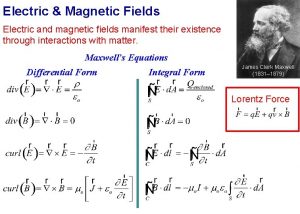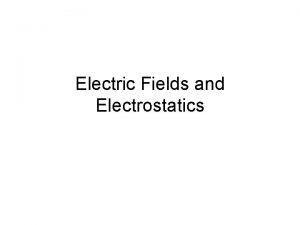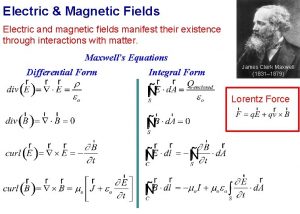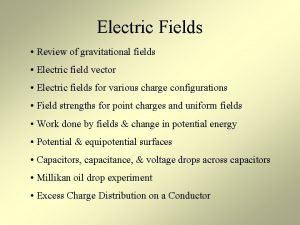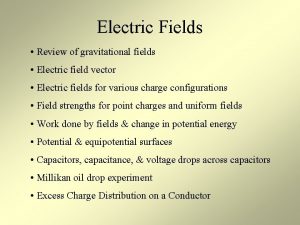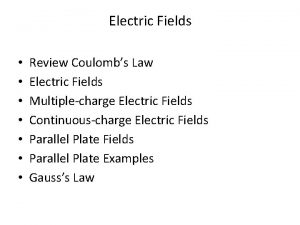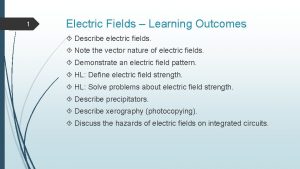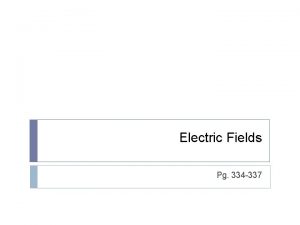Electric Fields and Waves EFW John Wygant EFW






















- Slides: 22

Electric Fields and Waves (EFW) John Wygant EFW PI University of Minnesota Radiation Belt Storm Probes SRMDR 1

Agenda • • • • Investigation team Overview Hope Magnetometer Boom Driving requirements Star Tracker Science compliance Primary measurement RF Antenna requirements (aft) Design description Shunts (4 x) Interface definition Louvers Heritage Technology development plan Resource summary Operations concept SP Wire Boom (4 x) RPS Verification & validation REPT Risks & mitigation Phase B plans Radiation Belt Storm Probes SRMDR RP-Spice Mag. EIS (4 x) - [Low, Medium (2 x), High] Axial Boom (aft) 1 of 2 Battery Radiator DSAD (2 x) 2

Investigation Team RBSP EFW PI J. Wygant, UM PM/SE Science Co-I’s P. Harvey, UCB Financial Mgr K. Harps, UCB QA R. Jackson, UCB Subcontracts J. Keenan, UCB Lead Mechanical Lead Electrical Sensors Signal Processor Ground Systems P. Turin M. Ludlam J. Bonnell R Ergun, LASP M. Hashii AXB: R. Duck SPB: G. Dalton Dynamics: D. Pankow Analog: H. Richard Digital: M. Ludlam FSW: P. Harvey LVPS: P. Berg Lead : J. Westfall Radiation Belt Storm Probes SRMDR 3

Overview RBSP Electric Field Waves Features Four spin plane booms (2 x 40 m and 2 x 50 m) Two spin axis stacer booms (2 x 6 m) Spherical sensors and preamplifiers near outboard tip of boom (400 k. Hz response) Flexible boom cable to power sensor electronics & return signals back to SC Sensors are current biased by instrument command to be within ~ 1 volt of ambient plasma potential. 1 Main electronic box (filtering, A-D conversion, sensor bias control, burst memory, diagnostics, mode commanding, TM formatting ) 4 5 6 EFW Science quantities include: • E-fields: (V 1 -V 2, V 3 -V 4, V 5 -V 6) • Interferometric timing: SC-sensor potential (V 1 s, V 2 s, V 3 s, V 4 s, V 5 s, V 6 s) • SC Potential : (V 1+V 2)/2, (V 3+V 4)/2 3 2 Interface to EMFISIS instrument Electrostatic cleanliness spec: variations of potential across spacecraft surfaces smaller than 1 Volt. Radiation Belt Storm Probes SRMDR 4

Overview Science Objective: Measure electric fields associated with a variety of mechanisms causing particle energization, scattering and transport in the inner magnetosphere. These mechanisms include: Energization by the large-scale convection E-field. Energization by substorm injection fronts propagating in from the tail. Radial diffusion of energetic particles mediated by ULF MHD waves. Transport and energization by intense magnetosonic waves generated by interplanetary shock impacts upon the magnetosphere. Coherent and Stochastic acceleration and scattering of particles by small-scale, large-amplitude plasma structures, turbulence and waves (EM and ES ion cyclotron waves, kinetic Alfven waves, lower hybrid, small scale magnetosonic waves, solitary waves, other nonlinear structures) EFW measurements address all 8 of the RBSP science goals with a lesser contribution to goal 6 Radiation Belt Storm Probes SRMDR 5

Science Compliance EFW X X X X RBSP Science Objective identify the processes responsible for the acceleration and transport of relativistic and near-relativistic particles, determine when and where these processes occur, and determine their relative significance. identify the processes responsible for the precipitation and loss of relativistic and near relativistic particles, determine when and where these processes occur, and determine their relative significance. quantify the processes that lead to the formation and subsequent decay of transient radiation belt structures. quantify the relative contribution of adiabatic and non-adiabatic processes on the acceleration, transport, and loss of energetic particles determine the role of "seed" or source populations for relativistic particles. quantify the effects of the ring current and related storm phenomena on relativistic particles quantify how and why the ring current and associated phenomena vary during storms use the science understanding to improve and validate physics-based Belt Storm Probes SRMDR data assimilation Radiation and specification models for the Earth’s radiation 6 belts

Science Compliance Radiation Belt Storm Probes SRMDR 7

Primary Measurement Requirements Radiation Belt Storm Probes SRMDR 8

SPB Description q Mass: 2. 20 kg/unit (4 total). q Envelope: 9. 9”H x 4. 6”W x 8. 6”D. q Deployed Length: 80/100 m tip-to-tip. (47 m cable + 3 m fine wire in each SPB. ) q Deploy Rate: 0. 5 -1. 0 cm/s. q Cable Mass Rate: ~3 g/m. q Fine Wire Mass Rate: < 1 g/m. q Preamp Mass: 48 g (up to 150 g w/up-shield and cable driver). q Sphere/Keyreel Mass: 100 g. q Deployed spin MOI: 1920 kg-m 2 total q Power: 2. 6 W/unit (typ. , deploy motor only). q Actuators: Doors are spring-loaded, SMA-released; Cable deploy is motor-driven; no pyros required for actuation. Radiation Belt Storm Probes SRMDR 9

AXB Description q Mass: 6. 21 kg total (2 booms + tube). q Footprint: 26” H x 6. 400” OD inches. q Deployed Length: 13 m tip-to-tip. q 0. 5 -m whip sensor stacer. q Power: 35 W max per boom for release q Actuators: Frangibolt sphere release, main boom release. q Deployment is motor-driven Flight Axial Tube & one AXB from THEMIS Radiation Belt Storm Probes SRMDR 10

IDPU Description q Mass: 4. 6 kg. q Dimensions: 9. 75 H x 4. 7 W x 7. 95 D inches q Power: 7. 8 W CBE. q Elements and Function: • Chassis – provides structural and rad shielding • Backplane – signal and power distribution. • Low-Voltage Power Supply (LVPS) - conversion • Power Controller Board (PCB) – switching • Data Controller Board (DCB) – cmd & telem • Solid State Recorder - data storage • Boom Electronics Board (BEB) – sensor control. • Digital Fields Board (DFB) –signal processing. • EMFISIS Interface – buffering of E & B signals Radiation Belt Storm Probes SRMDR 11

Flight Software Description q Development Plan : RBSP_EFW_SW_001 q Requirements: NPR 7150. 2 V. Sep 27, 2004 q Heritage : CRRES, Polar, Cluster, THEMIS q Language: 8085 q Functional Requirements: ~200 q Effort : ~10000 SLOC in 22 modules q Test Platform: ETU q Phases: 1. Board, 2. Box, 3. Inst, 4. Autonomy q Management: Resource Track, Req’s Met q Quality : Integrated with Flight Development q Major Functional Elements: v Command Reception & Distribution v Real-Time Data Collection and Playback v On-Board Evaluation for Burst Triggering v Burst Data Collection and Playback v Sine-Wave Fits of E-Field Signal v Delta Mod Compression v Boom Deployment Control Radiation Belt Storm Probes SRMDR 12

Interface Definition SPB 1 X-Axis SPB 2 COMMANDS SPB 3 IDPU Y-Axis TELEM SPB 4 AXB 1 AXB 2 MAIN +28 V SPB Power Z-Axis EFW X, Y, Z MAG X, Y, Z SCM X, Y, Z AXB Power EMFISIS Radiation Belt Storm Probes SRMDR 13

Heritage Spacecraft SPB’s S 3 -2 4 S 3 -3 4 ISEE 2 VIKING 4 FREJA 6 FIREWHEEL* 2 CRRES 2 POLAR FAST 4 CLUSTER I* 16 CLUSTER II 16 THEMIS 20 SPARES 26 Lunar Prospector Sounding Rockets ----110 AXB’s 2 4 2 10 6 ~50 ----26 -76 * LV did not achieve orbit Radiation Belt Storm Probes SRMDR 14

New Development Items Boom Deployment Systems Units based on ISEE, CRRES, Polar, FAST, Cluster-II, and THEMIS heritage. Changes will include thinner cable, using SPB-type motor type for AXB instead of brake. Sensor Electronics (Preamp and BEB) Units are based on Polar, Cluster-II, and THEMIS heritage. Changes will include thinner cable, possible cable driver. IDPU Power, DSP, DPU, and Burst Memory Units are based on Polar, FAST and THEMIS heritage. Changes will include interfaces to other instruments and SC, adjustments to filter frequencies and ADC rates, flight software changes. Radiation Belt Storm Probes SRMDR 15

Resource Summary CBE (NTE) • • • Mass: 21. 3 (23. 6) kg Power: 7. 8 (8. 6) W Telemetry rate: 16. 5 (16. 5) kbit/sec Radiation Belt Storm Probes SRMDR 16

Operations Concept • Commissioning – Draft Deployment Sequence Delivered to APL – Sequence takes approx 2 weeks including science diagnostics – Z-axis adjustment operations are to be decided • Normal operations – Constant Real-Time Data Streaming – Playback of stored events • Bursting – Automatic detection of interesting events – Burst Flag sent to S/C • Command data handling – Commands determined and sent from UCB – Telemetry distribution at UCB – SOH determination at UCB • SOC Operations will be run from UC Berkeley Radiation Belt Storm Probes SRMDR 17

Instrument Verification & Validation Plan EFW Verification Plan (RBSP_EFW_SYS_300) Mass Props CPT Preamp √ √ Sensor √ √ SPB √ √ √ AXB √ √ √ IDPU √ √ √ Unit EFW Inst. Deploy EMC MAG Vib TVAC Calibration √ √ √ Radiation Belt Storm Probes SRMDR 18

S/C Level Instrument V & V Plan EFW Will Support APL’s Verification of Spacecraft EFW Flow Will be as Simple as Possible Expect “Bolt-Hole” Alignments are Sufficient for Boom Systems EFW-EMFISIS Verification Expected to Require Boom Deployment of Spin Plane Booms and +Z Axial Sensor is Practical at I&T Fields Phasing EFW Space craft EFW EMFISIS Func Test EMC Electrostatic Cleanliness Commanding Compatibility √ √ √ √ Radiation Belt Storm Probes SRMDR √ 19

Risks and Mitigation 5 L I K E L I H O O D 4 3 4 2 1 5 2 3 1 1 2 3 4 5 CONSEQUENCES Criticality L x C Trend Decreasing (Improving) High Increasing (Worsening) Unchanged Med * New since last month Approach M – Mitigate W – Watch A – Accept R - Research Low Radiation Belt Storm Probes SRMDR 20

Risks and Mitigation Radiation Belt Storm Probes SRMDR 21

Phase B Plans Activities 06/08 EFW Instrument Requirements Review 09/08 EFW Instrument Preliminary Design Review 09/08 EFW SOC Preliminary Design Review 11/08 Support MPDR 01/09 SPB ETU Design, Fab & Test 01/09 AXB ETU Design, Fab & Test 12/08 IDPU ETU Design, Fab 12/08 Harness ETU Design, Fabrication 12/08 S/C – EFW Interface Test (Emulator) Radiation Belt Storm Probes SRMDR 22
 Red fields to green fields
Red fields to green fields Electric forces and fields concept review
Electric forces and fields concept review Chapter 16: electric forces and fields answers
Chapter 16: electric forces and fields answers Chapter 33 conceptual physics
Chapter 33 conceptual physics Electric currents and magnetic fields
Electric currents and magnetic fields Electric currents and magnetic fields
Electric currents and magnetic fields Compare and contrast p waves and s waves using venn diagram
Compare and contrast p waves and s waves using venn diagram Electric fields quiz
Electric fields quiz Electric fields
Electric fields Electric fields
Electric fields Induced electric field
Induced electric field Physics 2 study guide
Physics 2 study guide Chapter 22 electric fields
Chapter 22 electric fields Lowest point of a wave
Lowest point of a wave Examples of mechanical waves
Examples of mechanical waves Mechanical and electromagnetic waves similarities
Mechanical and electromagnetic waves similarities What is a semiconductor used for
What is a semiconductor used for Difference between matter waves and electromagnetic waves
Difference between matter waves and electromagnetic waves Similarities of mechanical and electromagnetic waves
Similarities of mechanical and electromagnetic waves Seismic waves
Seismic waves Mechanical wave and electromagnetic wave
Mechanical wave and electromagnetic wave Constructive waves and destructive waves difference
Constructive waves and destructive waves difference John mccrae in flanders fields
John mccrae in flanders fields







